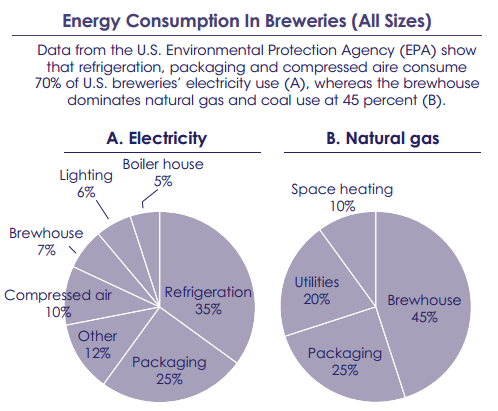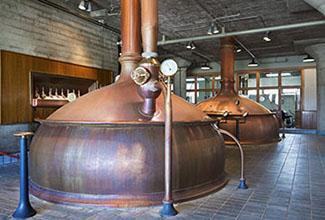RHC for Breweries
- About this sector
- Sector opportunities and challenges for project development
- Cost of RHC technologies
About This Sector
In 2010, the United States beverage industry consumed about 70 trillion Btu of energy:1
- 32 trillion Btu in process uses (e.g., process heat, refrigeration, mechanical drives)
- 25 trillion Btu in boiler fuel
- 11 trillion Btu in non-process use (e.g., heating, ventilation, air conditioning, lighting, onsite transportation)
Within this sector, the United States has more than 2,500 breweries and brew pubs.2 Breweries use particularly large amounts of energy because many steps in the brewing process involve heating or cooling, including kiln-drying and roasting the malt, heating the mash (a mixture of grain and water), boiling with hops, rapid cooling, and refrigeration or cold storage. Other uses of hot water include cleaning and sterilization.

Sector Opportunities and Challenges for Project Development
Several factors make breweries good candidates for renewable heating and cooling (RHC) projects:
 The brewing process uses large amounts of hot water, and process heat and boiler fuel constitute a significant percentage of the energy used in the industry. Renewable heating technologies can help reduce costs and serve these loads.
The brewing process uses large amounts of hot water, and process heat and boiler fuel constitute a significant percentage of the energy used in the industry. Renewable heating technologies can help reduce costs and serve these loads.- Breweries may be able to supplement or replace fossil fuel use in existing combustion boilers or process heat systems with biomass fuels. These renewable fuels could be available from a variety of sources, depending on the location of the brewery and local resources. Breweries might even be able to use their own waste products as a renewable fuel source.
- Many breweries have realized a return on investment in renewable heating and cooling projects within 10 years. The Brewers Association estimates as little as a 1.5-year payback for solar water heating systems in brewery applications.
Renewable heating and cooling projects in this sector also face some challenges:
- Some breweries require higher process heat temperature levels than what commercially available renewable heating technologies can deliver. Under these circumstances, breweries can consider pre-heating as a possible alternative.
- Successful and economical integration of a renewable heating system requires detailed procedural knowledge of the brewing process. To balance system supply with demand, all at the correct temperature profile, the facility must create load profiles that represent the stages of the brewing process. This analysis takes time.
- Breweries have specialized equipment and systems (e.g., boiler fuel feeding systems, piping, burners, storage), and custom modifications to these systems could cost more than modifying more conventional stock equipment.
- Heat is a heterogeneous commodity with differing temperatures in both demand and renewable heat supply. A brewery will likely need a renewable system that is designed to efficiently provide heat at a wide range of temperatures.
Costs of RHC Technologies
The total cost of developing renewable heating and cooling systems can vary based on a number of factors, including the state policy environment, physical geography, available incentives, labor rates, and more. The following cost information is sourced from the National Renewable Energy Laboratory (NREL)3 and should not be interpreted as statistically accurate or sector-specific, but instead should be taken only as rule-of-thumb information and used only for a first-pass screen of economic viability. Visit NREL's website for more detailed information about other costs and typical project lifetimes.
| Technology type | Mean installed cost ($ per square foot) |
Installed cost range (+/- $ per square foot) |
Operation and maintenance cost |
|---|---|---|---|
| Solar water heating: flat-plate and evacuated tube collectors |
$141 | $82 | 0.5 to 1.0% of initial installed cost |
| Solar water heating: plastic polymer collector (unglazed) |
$59 | $15 | 0.5 to 1.0% |
| Technology type | Mean installed cost ($ per ton) |
Installed cost range (+/- $ per ton) |
Operation and maintenance cost |
|---|---|---|---|
| Ground source heat pump | $7,518 | $4,164 | $109 +/- $94 |
| Technology type | Mean installed cost* ($ per kilowatt) |
Installed cost range (+/- $ per kilowatt) |
Fixed operation and maintenance cost ($ per kilowatt) |
|---|---|---|---|
| Biomass wood heat* | $600 | $361 | $91 +/- $33 |
*Biomass wood heat converted from thermal energy capacity (Btu per hour)
- Learn more about solar, geothermal, and biomass technologies.
- Learn more about financial incentives for RHC.
1 U.S. Energy Information Administration. 2013. 2010 Manufacturing Energy Consumption Survey. Table 5.4. End Uses of Fuel Consumption, 2010.
2 Brewers Association. 2014. Number of Breweries. Exit This number is current as of 2013.
3 National Renewable Energy Laboratory. 2013. Distributed Generation Renewable Energy Estimate of Costs. Updated August 2013.
